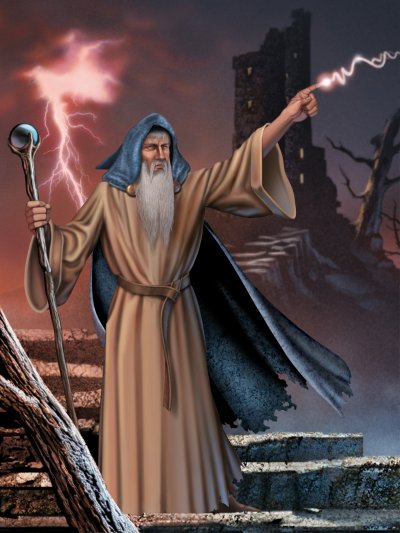 |
THE
WIZARD OF OZ
Rick Archer's Note: The following story is
important to me for several reasons.
Recently a
neighbor mentioned he had retired. After I
congratulated him, he said he needed to send me his non-work
email address so he could continue receiving the SSQQ
Newsletters. It turns out he likes some of the jokes
and stories.
Flattered by his
interest, I asked if my stories helped him believe in Fate.
He answered with
a smile, "One thing I'm certain of is that you believe in
it."
Which is true.
I am a firm believer in Fate. Which is why I like this
story. It has Fate written all over it. It is
the story of how a talented and very proud man got taken to
the cleaners twice in a row at the peak of his career.
A street hustler conned him to the tune of a half million
dollars while some Aussie guy named Rupert Murdoch stole his
life's work right out from under his nose. Talk about
a double dose of humiliation. He lost his job and he
lost his reputation.
Knocked for a
loop, some people might have thrown in the towel. Not
this guy. He came up with one of the ingenious
comeback plans I have ever heard of. He waved his
magic wand and produced a movie known as Urban Cowboy
out of thin air.
I doubt anyone
else has ever told this man's story. The only reason I
know the tale is because my dance career hitched a ride on
this man's comet. As he soared, so did my career as
Houston's first Country-Western instructor. This is a
very curious tale; I think you will enjoy it. --
Rick Archer
|
|
MAGIC CARPET RIDE
the disco
years
CHAPTER EIGHTY SIX:
THE WIZARD OF OZ
Written by Rick
Archer
|
|
SEPTEMBER
1979. THE YEAR
OF LIVING DANGEROUSLY
THE MYSTERIOUS WIZARD OF OZ
|
|
Rick Archer's Note:
So what exactly
led to my career as a Country-Western dance instructor?
Probably the best place to start is the secret behind Houston's
strange Western Transformation in 1979. The spark that started
this bizarre Transformation was the opening of
Cowboy, the first C&W club to ever attempt to
attract wealthy professionals to a kicker joint.
Starting with Cowboy
in February 1979, over the next six
months two dozen or so Houston-area
Discos had closed only to reopen a month later as a
Western dance hall. As the result of these unexplained changes, at the start of September
only four well-known Discos were still standing...
Annabelle's, elan, Tingles, and Pistachio Club.
This phenomenon
upset me no end. The Death of Houston Disco Clubs was like
Russia burning its crops to stop Napoleon. Without
food to feed his troops, Napoleon had no choice but fold his
tent and head back to France. By comparison, if my students did not have a place to
dance, Disco would starve to death.
Here is what was
weird about Houston's Western Transformation.
Simultaneous to the demise of Disco in Houston thanks to the
Country-Western threat, Disco was hitting its absolute popularity
peak in every other part of America. Indeed,
while Disco was on its death bed here in Houston, it was
gangbusters everywhere else. Houston was the lone exception.
"Why?", I asked. What possible
reason could explain why Disco was facing a premature death
in Houston? I asked around,
but no one had any idea. We figured it had something to do with
John Travolta and this strange movie he was filming, but as
I would later learn,
that was just the tip of the iceberg. Clearly there
was more to this mystery. At the time, my
conclusion was that someone was orchestrating these changes
behind the scenes. In my thoughts, I referred to the
mystery man
as the Wizard of Oz.
|
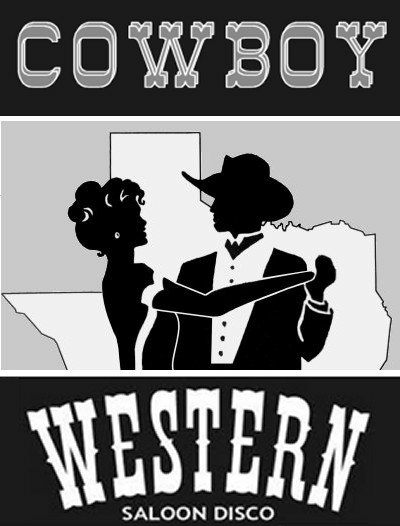 |
As it turned
out, I was absolutely correct. There was indeed a Wizard of
Oz behind all these changes. Now for the
irony. I never learned who he was until 40 years later.
Why did it take so long? For one thing, although there
were plenty of articles about John Travolta, Gilley's,
and the filming of Urban Cowboy, there were no
articles in the newspaper to explain the Western
Transformation.
Why not?
Because no one particularly cared. Curious, maybe, but
not threatened. Wait, let me change that.
There was one person who cared. Me. I would
venture a guess I was probably the only person in
Houston whose profession was threatened with extinction by
Urban Cowboy. It wasn't like anyone else
was out of a job. The club owners still owned a club
while all the bartenders and waitresses had to do was go out and buy a pair of jeans. Sure, there were other Disco instructors who
were inconvenienced, but they just went back to teaching
Ballroom. And yes, my Disco students were very
irritated, but unlike me, they did not wrap their entire
existence around Disco. If Disco went away, they would
adapt. Not me. Disco was my identity, my
reason to be happy. Why not teach Ballroom? I
hated Ballroom dancing and I hated the music. Why not
teach Western? I hated the music and there was nothing
to teach.
|
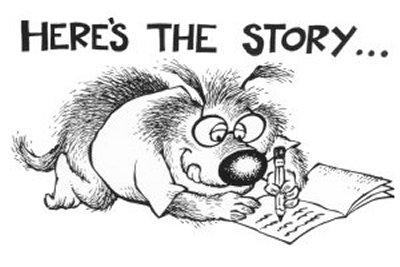 |
Given how much I loved to teach dance, my
depression grew worse as my Disco classes grew smaller.
The end of my dance career seemed right around the corner.
The worst part of it was my inability to grasp what
had caused this bizarre turn of events. My
helplessness was driving me to madness. Why?
It made no sense.
Since there was no Internet in 1979,
it was not until I
began writing my book that I began to research the whole story.
As it turned out, the behind-the-scenes tale of Urban
Cowboy was amazing. I doubt you will ever read
a stranger story in your life.
|
HOUSTON'S WESTERN TRANSFORMATION
|
|
Before we begin the
background story of Urban Cowboy, let's read this article
about Houston's Western Transformation again.
|
| |
|
C&W
Nightclubs Riding High
Written by Michael Demarest
Time Magazine, 1981
In 1975 Houston had at most a dozen Cactus
Cabarets.
By the time 1981 rolled around, Houston now had more than 300, few of which cared to
emulate Gilley's Dodge City outlaw style.
In February 1979,
McFaddin-Kendrick, a Houston-based conglomerate, opened
Cowboy, the city's first upscale Twostep saloon
after doing extensive market research. Following its success with
Cowboy, McFaddin-Kendrick
then went on to launch a national chain of 40 western barns that
mixed country music with disco music.
Cowboy's success revolutionized the club industry. Before then, there was no such thing as a "classy"
country place. It used to be your choices ranged from
your standard
country dump #1 such as Gilley's to your standard country dump #2.
No one recognized the market for
"attractive" western clubs even existed. For that
matter, no
one had any idea it was possible to successfully mix disco
music with
country and western under one roof without people killing
one another. However, once Cowboy took off for the moon in
typical Space City fashion, everyone else jumped on the
bandwagon and opened Cowboy imitations.
The most successful,
Fool's Gold and San
Antone Rose, were located in affluent Houston residential
areas and, like Cowboy, catered to the Gucci gauchos.
Imitation proved to be the most sincere form of flattery.
|
WHAT EXACTLY IS A 'CACTUS CABARET'?
|
|
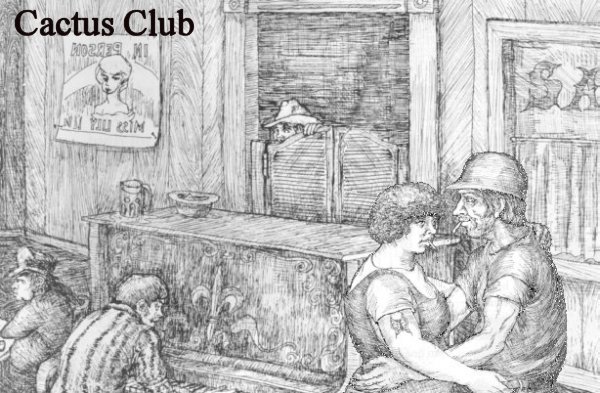 |
What a shame the
William Demarest article was not published in 1979.
Since I did not know the future, I was deeply immersed in gloom
at this stage. I was dying to know the
answer behind all of these unexplained changes, but no one
could help me.
Every now and then someone asks me if I would have done
anything different about my problem. Yes, if I had to
do it over again, I would have visited Cowboy
when it opened. As
it stood, I would not visit Cowboy until November
(two months further down the road from our current
point in the story).
As one can imagine, Joanne's Cactus Club was a
good example of William Demarest's "Cactus Cabaret"
reference. What a dump! Now here is the irony.
As it stood, I labored under the
misconception that Cowboy was just another
dreary, run-down Dodge City honky tonk that looked just like Cactus Club.
Such was not the case. In reality, Cowboy
was a veritable palace. But I did not know that
because I refused to visit the place. As we shall
see, I would pay a serious price for my Ostrich-style unwillingness to
face my fears.
|
We
have a saying here in Texas: "Don't put the Cart
Before the Horse."
This
is another way of reminding us the 'Effect' should
follow the 'Cause'. In other words, first you
have Saturday Night Fever, then you have
30 new Discos in Houston. Cause and Effect.
Such was not the case with Urban Cowboy.
The movie was not scheduled to appear until June 1980.
So why are all these Western clubs opening ONE YEAR BEFORE Urban
Cowboy?
I knew this mysterious Cowboy
had somehow initiated these 'Disco to Western'
changes.
I also knew John Travolta and Gilley's
were connected to the mystery. What I did not
understand was why the Disco clubs were in such a hurry to
close down and reappear as Western clubs.
When Cowboy first appeared in Houston at the
start of 1979, Disco clubs throughout America were doing
sensational business. This was true in Houston as
well. If Houston's clubs had maintained a Disco format
throughout 1979, I guarantee these clubs would have made a
healthy profit. Therefore the decision to switch to a
Western format one year early was totally unnecessary.
Hey, guys, what's the
rush?
For this reason, I was convinced some sort of mastermind was
responsible. Clearly these club owners were acting on
inside information.
|
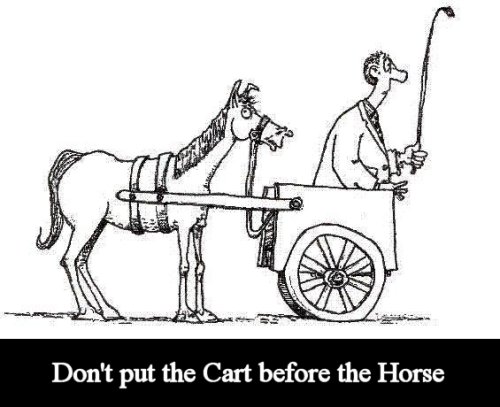 |
Of course I was panic-stricken. It was not just my
career that was threatened, Disco was my entire life.
It was everything I lived for, my total identity, my only
claim to fame. The fear of becoming a nobody again haunted me
night and day. I ripped my hair out trying to
understand why these Disco clubs would shut down for a movie
that was not even filmed yet. Furthermore, the total
unanimity led me to believe these club owners knew
something that I didn't. If one or two clubs had
changed their spots, I could understand that. But
thirty clubs? Maybe even forty clubs? Good
grief, I was witnessing something akin to a buffalo stampede!!!
Making things even weirder, no one seemed to care about
Urban Cowboy, at least not in my circles.
Given zero interest in Western dancing among the people I
knew, on
the surface this stampede seemed like a huge gamble.
Disco was making Big Money in 1979, so why trade a sure thing for an unknown?
My conclusion was that these dance club owners had to know
something exclusive only to them. What could it be? Since these developments made no sense, I
developed a theory that something was going on behind the
scenes that no one but a select few here in Houston were in
on. There was someone out there, some sort of 'Wizard
of Oz' who orchestrated these changes.
But who was it? Who could it be? Tell me his
name so I could go shoot him!
|
CLAY FELKER: THE MAN WHO
INVENTED NEW YORK |
|
Rick Archer's Note:
Before we begin, please keep in mind
I wrote my story about Clay Felker 40 years after the events
described. What I have written is based entirely on
snippets culled from various Internet stories.
Considering there is not one piece of first-hand knowledge
involved here, I apologize for any inaccuracies. That
said, I think the story I have shared is pretty close to
what took place at the time. Although the Reader may
recall I covered these details at the start of my book, I
hope you won't mind if I review the story for better
understanding.
|
As founder and editor of New York
magazine, over the years Clay Felker published one
ground-breaking story after another. Often referred to as 'Mr. New
York', Felker had three great talents. First, he
hired the best writers in the world. Second, he threw
the most lavish parties New York had ever seen.
Celebrities and politicians craved an invitation.
During those parties, Felker and his talented writers made
sure to pick up on the latest gossip and use it to their
advantage. Third, Felker had a gift for spotting a
good story. Nancy Newhouse, a senior editor in the
early years of
New York magazine, once said this about Clay Felker:
"I have never seen
anyone who was as open to his intuition as Clay was. He
had no barriers between his intuition and himself. Most
of us have all kinds of defenses. But with Clay, there
was no barrier. Sometimes he was wrong, but he was right
enough of the time, spectacularly right, that it was
astounding."
In other words, Clay Felker was the guy with his finger on
the pulse of the Greatest
City in the World. Or, as Tom Wolfe put it, he was the Man
Who Invented New York.
Clay Felker was famous.
He was,
a major Somebody. However, at the height of his career, a
Nobody named Nik Cohn used Felker as springboard for one of the greatest scams in
journalism history. This is a great story, but why is
it relevant to my book?
Rick Archer owes his entire dance career to this tale.
|
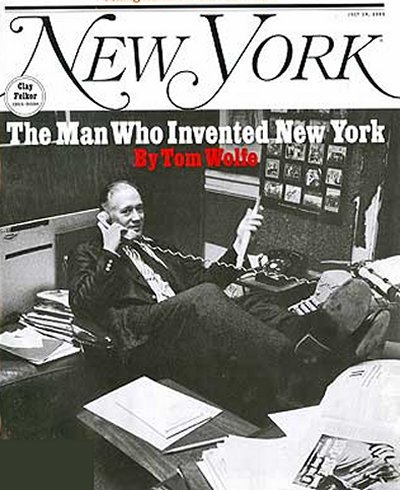 |
 |
In a 2016 article written for The Guardian,
Nadia Khomani had this to say about Nik Cohn:
"Saturday Night Fever was released in 1977, and has since
grossed $285m worldwide.
The soundtrack became one of the
best-selling film albums of all time after staying at #1
for 24 consecutive weeks, reinvigorating the Bee Gees' music
career in the process.
John Travolta became one of the
youngest actors ever to be nominated for the best actor Oscar.
Decades
later, not many people remember that this phenomenon was down
to one man: Northern Irish rock critic Nik Cohn thanks to
his story Tribal Rites of the New Saturday Nights in
New York magazine."
|
Catapulted to fame when Saturday Night Fever
became a smash hit, Nik Cohn began living the high
life. Nadia Khomani captured
Cohn's upgraded lifestyle in vivid fashion.
"Picture it: A writer pens a magazine article, an instant
sensation. Producers come calling, he sells the rights for
tens of thousands, the tabloids give him a nickname,
acquaintances greet him as a friend, checks flood in, he
attends the premiere of his film in Los Angeles with a
famous disco singer on his arm. It's glitzy, it's glam, it's
Hollywood, baby. But as he makes his way through the frenzy
outside the theatre, through security, paparazzi and
screaming teenage girls, he is filled with moral panic. Why?"
What is this 'Moral Panic' Ms. Khomani refers to?
In 1997, 20 years after his glory days, Nik Cohn confessed he had made up the entire story
and slipped the counterfeit tale past Clay Felker.
That was pretty slick, but the real pay-off came when Cohn
turned around and exploited producer Robert Stigwood for a
bonanza that was the stuff of dreams. Stigwood had
made a mistake. He had signed Travolta to a Million
Dollar contract only to find out after the ink dried that
Grease was not available to be filmed for
another year. Spotting Cohn's fake story in New
York magazine, Stigwood knew instantly Travolta would be
perfect as the moody dance stud with a big chip on his shoulder.
|
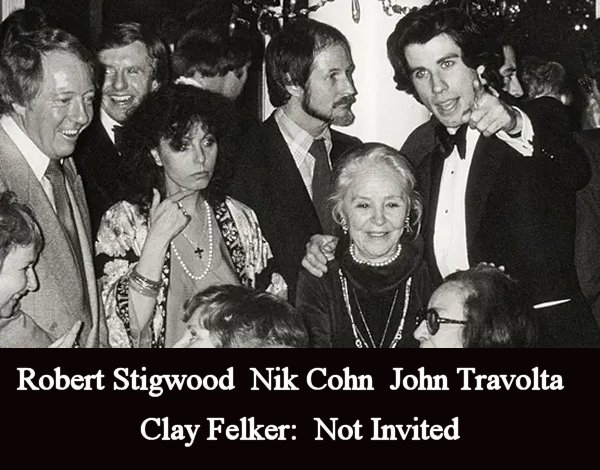 |
So how exactly
did Nik Cohn pull this off? He had the
advantage of inside information.
Back in England, Cohn
had been hanging out with a famous rock group known as
The Who ('Who are You', 'Pinball Wizard').
Robert Stigwood was their manager. During the filming
of Tommy, a rock musical based on an album
recorded by The Who, Cohn was invited by the band's leader,
Pete Townshend, to visit the set. That is how
Cohn met Bill Oakes, an RSO music executive (Robert
Stigwood Organization).
When Stigwood relocated
his operation to
New York City, Oakes invited Cohn to come along and sleep on
his couch till he could find a place of his own. Cohn
parlayed his connections with RSO into a job as music critic
for Felker's magazine. That led to an assignment to
check out the dancing at a Brooklyn nightclub. As it
turned out, there was street brawl right in front of the
Disco. Nik Cohn was too afraid to even get out of his
taxi. So he watched a while, then decided to use his
imagination to write a fake story based on characters he had met in
the London Mod Scene.
After he
finished, Cohn handed the article to Bill Oakes and asked him to
take it over to RSO as a potential movie script.
Kevin McCormick
was
in charge of film development for Robert Stigwood. The
moment McCormick read the
story, he saw the potential
and engaged Nik Cohn in preliminary talks. Cohn agreed to $10,000 for an option on
his article with Kevin McCormick on board to
produce the movie if Stigwood approved. However the deal had not been
finalized.
When Cohn told
his buddy Bill Oakes about McCormick's interest, Oakes said, "Before
you go back, why don't you see if you can get your story published? Stiggy
(Stigwood) is a lot more likely to pay
attention if you can get it into New York magazine
first."
|
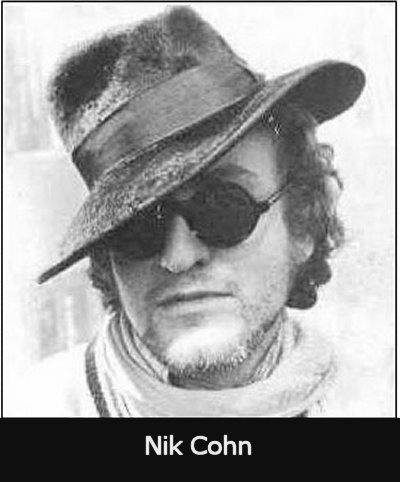 |
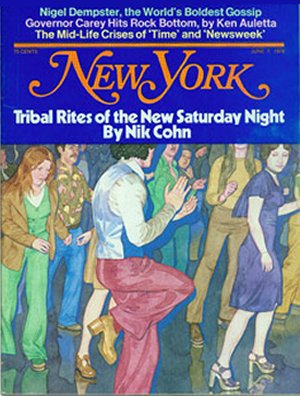 |
Cohn was an aggressive guy. He could have waited to
approach Felker at work the next day, but he was impatient
to get Stigwood on board.
That night Cohn went to the trouble of tracking
the editor down while Felker and several friends ate dinner at a posh New York
restaurant.
Imagine the chutzpah. Try to
picture the nerve it took for this
scruffy street hustler to walk uninvited into a restaurant
and interrupt his boss while Felker entertained celebrity friends. Right in the middle of the meal,
some lowly unknown music writer breaks in to pitch a story
about a bunch of poor Brooklyn teenagers who liked to dance.
Startled, Felker decided to listen as Cohn explained that his story depicted the dance
world of disadvantaged teenagers who lived in Brooklyn.
Every Saturday night this tight-knit group wrapped their entire lives
around Disco dancing in the clubs.
To Cohn's dismay, Felker
laughed in his face. Ridiculous! Then
Felker rubbed it in. With Cohn standing there, Felker
embarrassed the young man by asking his dinner guests what
they thought about a story covering
the Saturday night dance habits of young working-class
Italian-Americans.
Understandably these important
cognoscenti scoffed.
Who gives a flip about a bunch of teenagers who like to dance on Saturday
night? They had heard it all before. This lame
story could just as easily been written about dancing to
surf music in Beach Blanket Bingo.
Hearing the scorn in his friends' voices, Felker told Cohn to forget it.
To him, Disco music was a fringe phenomenon
exclusive to boring lower-class youth. No one who read
his magazine could possibly be interested.
Cohn was crushed, but he wasn't going to give up easily. He
went behind the editor's back to speak to Felker's business partner Milton Glaser.
Glaser liked James McMullan's artwork so much he decided to
champion the story. Despite mixed feelings, Felker
gave in and let the story run. Nik Cohn's
story, Tribal
Rites of the New Saturday Night,
was published on June 7, 1976.
|
The moment
Cohn's Disco story was published, Bill Oakes made sure
a copy of the magazine landed on Stigwood's desk.
Timing is everything. At the exact moment beads of
sweat began pouring off Stigwood's brow over his
Grease dilemma, Stigwood noticed Cohn's Disco
story right in front of his nose. Stigwood recognized
instantly that he could plug Travolta into this story, but
then he panicked.
"Oh my God," Stigwood thought, "what if someone
else sees the potential in this story?"
Here's the funny thing.
What potential? Disco was hardly a household
word in those days, but Stigwood did not know that.
All he knew is Travolta needed a movie to star in this very
minute and this story had appeared out of nowhere like a
gift from the Universe. Although the details are
murky, there is reason to believe Oakes was keeping Cohn
posted on the developments. Look at it this way.
It was quite a coincidence that Cohn wrote this story at the
exact same moment Stigwood was agonizing what to do about
Travolta. That is why I sometimes wonder if Cohn knew
about Stigwood's 'Travolta problem' ahead of time
when he wrote his fortuitous story.
In 2007, Sam Kashner wrote a terrific story about
Saturday Night Fever in Vanity Fair.
One particular item caught my eye.
"Back in the
Seventies it was almost unheard of to buy a magazine
article for a movie, but 'Tribal Rites' attracted enough
attention that producer Ray Stark (Funny Girl) and a few
others bid on it."
Sam Kashner made the point that Robert
Stigwood was not the only person who noticed the dramatic
potential of Nik Cohn's story. My theory is that once
Cohn got his article published, he pitched his story to
every producer in town, thereby driving up the price.
One thing for sure, Oakes came back and told Cohn that
Stigwood was hooked on the story. "You won't
believe this, but Stigwood told his lawyer he thinks this
movie will make a hundred million!" Oh
really? Since the deal with McCormick had not been finalized,
once he knew about Stigwood's interest, Nik the Slik raised the price. Cohn let
it be known to all concerned that another producer had read the story in Felker's
magazine and was really interested. Imagine that. "Gosh, I'm
sorry, but my price tag has just gone up."
Hmm.
Stigwood's lawyer
smelled a rat.
Sensing they were being hustled, the
lawyer suggested
Stigwood back off. Stigwood would
not hear of it. After all, Stigwood's intuition told him
this movie could be worth a hundred million
dollars.
Convinced he had to have this story at
all cost,
Stigwood
said,
"I'm going to pay the kid whatever
he wants!"
After telling
the lawyer he would handle it himself,
Stigwood
nailed
down the deal by
offering Cohn
the moon and the sun.
First
Cohn was paid $90,000
for rights to his story. Then Stigwood gave
Cohn
first
shot at writing the screenplay for a guaranteed $150,000.
It did not stop there. Cohn negotiated percentage points
for the
upcoming soundtrack album.
This was unheard of. Yes, musicians got
percentage points, but never a writer. It had never been done before.
However, Cohn had
seen how much money The Who had made from
Tommy. Well aware he had the man over a
barrel, Cohn used his street smarts to con
Stigwood.
Who can imagine how much money Cohn made
once the music album became a best-seller? Estimates pegged it
at $500,000, maybe more.
What an incredible
stroke of luck! The
intricate timing caused by Stigwood's dilemma had transformed Cohn's story from a $10,000
windfall into a half-million Bonanza. Read that again:
Half a million for a fake story. It was the scam of
the century.
|
THE MOST BITTER MAN IN
AMERICA |
|
Rick Archer's Note:
If I had one wish, I would have loved to interview Clay
Felker. I combed the Internet high and low for any
sort of insight into his reaction after getting flimflammed
by Nik the Slik. Unfortunately I found nothing, not
even a tidbit. Since Mr. Felker passed away in 2008, I
suppose his private thoughts will follow him to his grave.
That said, I believe I know enough about this story to make
some educated guesses. Just remember to take
everything I say with a grain of salt. I do not wish
for anyone to mistake my conjectures as "Fact".
Let me start by explaining why I am so fascinated with Clay
Felker. First of all, I owe my dance career to this
man. I am not going to say why just yet, but take my
word for it. Clay Felker is the man who did more for my dance
career than any other person. I would be more grateful
if he hadn't caused me an
untold amount of misery by instigating Houston's Western
Transformation without telling me what he was up to.
However, since we never met, maybe I should be more
forgiving.
In addition, I have a deeply personal reason
to explain my interest. I would like to ask Mr. Felker
if he believed in Fate like I do.
Let me start by reminding everyone that my former boss,
Lance Stevens, called me "The Dance Teacher who Couldn't
Dance". It wasn't a very nice thing to say, but at the
time it was true. In the first year of my dance career
I was woefully inadequate. Nevertheless, right before
his eyes two really strange things happened. Slowly
but surely I turned into an excellent dancer. Practice
makes perfect. But even more remarkable was how my
Disco program grew to gargantuan proportions that dwarfed
the best Stevens could do.
How do you suppose that made my boss feel? Bitter.
That would be my guess. Stevens surely
had to wonder how a clod like Rick Archer pulled it off.
Was he suspicious of my Lucky Breaks? I speak of
things such as the Crossroad Synchronicity, the Partner
Dance Crisis, my chance meeting with Deborah Gordon, my
chance meeting with Glen Hunsucker, and the incredible
contributions of Victoria. I have tried very hard to
explain how I would have been hard-pressed to succeed on my
own merits. Stevens could see with his own eyes how
inept I was. So what could explain
my phenomenal success? Well, you already know my
answer. I gave credit to God and Fate. But I
doubt Stevens was wired to think that way. The
poor man must have been mystified to see me succeed against
all odds.
Lance Stevens saw himself as the best dancer and best
instructor in the city. He was the self-described "King
of the Whip". One picture after another lined the
wall trumpeting his impressive victories in major Ballroom
dance competitions. Stevens was at the top his game only to
see some snot-nosed brat steal his thunder. How did he
explain this unlikely development to himself?
|
I
came to see Clay Felker as a counterpart to Lance Stevens.
Felker was considered a genius.
The Internet is full of accolades for Clay Felker. I
read article after article praising his brilliance. Some say Felker was the man
who invented New York City thanks to one insightful story
after another. He hired gifted
writers whose articles gave the city its cachet. His
co-publisher Milton Glaser created the "I love New York"
logo. Felker was respected throughout the country as a
very clever guy.
And yet in the story that launched Saturday Night
Fever, one of the biggest stories of his career, Felker was totally fooled. He never saw it coming.
Here was a story that created a national phenomenon,
but Felker did not deserve a bit of credit for this
ground-breaking article. He wanted to reject it! Considering this was the man who was 'spectacularly right' most of the time,
it must have blown his mind to miss this one completely.
In a manner eerily similar to Lance Stevens, Felker was at
the top his game only to see some snot-nosed brat steal his
thunder. Although it is highly unlikely
Felker realized Cohn's story was a complete fraud at
the time, one can imagine the misgivings he felt when this
goofy story he had ridiculed magically skyrocketed to become a
major motion picture.
|
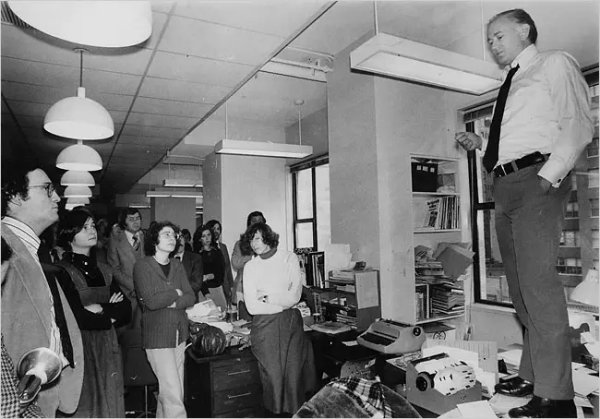 |
 |
Clay Felker's decision to publish Nik Cohn's false
Disco narrative in New York
magazine was the spark that created the nationwide
Disco phenomenon. Everyone praised him for his wisdom
to anticipate this unknown breaking trend. Hmm. Do you
suppose this development gave him any
satisfaction? I doubt it seriously. Once
Felker realized he had been badly outsmarted by a street
punk, he took little pleasure
in breaking one of the biggest stories of his career.
The nightmare did not stop there. Try to imagine how
Felker felt when the film proceeded
to make everyone wealthy and
famous beyond their wildest dreams. Everyone but
Felker,
that is. Clay Felker, the mightiest clairvoyant of all,
Mr. New
York, New York himself, had been reduced to a footnote
by a nobody.
I
wondered if Felker benefitted in any way from Cohn's story. In my research, I was unable to find a single story to
suggest Felker directly profited from the cultural phenomenon
generated by Cohn's Disco story.
Did Felker make any money? I doubt it. Does the
editor of the Houston Chronicle get money from an
award-winning expose printed in his paper? Probably
not. I could be
wrong, but I don't think Felker made a dime off
Saturday Night Fever. Meanwhile Nik Cohn
became famous and made an estimated half million dollars.
|
Perhaps Clay
Felker was too hard on himself. From my perspective, he never had a chance where
Saturday Night Fever
was concerned.
No one could have seen this result coming. That is
because it was Supernatural! If you think I am
kidding, nope, not this time. Robert Stigwood had John
Travolta and the Bee Gees in his pocket with no idea what to
do with them. Poof! Like the answer to a prayer,
the perfect story magically appeared out of nowhere. The luck of
having the perfect actor, the perfect story, and the perfect music
all at the same time was unbelievable. Thanks to this
Synchronicity, the Arrow of Destiny was pointed at
Robert Stigwood, not
Clay Felker.
Nik Cohn
had badly outsmarted Felker by planting a bogus article in
his magazine. Gaining credibility from getting his story
published over Felker's misgivings, Cohn's story attracted so
much interest that he was able to leverage Robert Stigwood
into the big payday. Then Stigwood turned around and waltzed off with the Grand Prize.
I imagine Felker felt badly used. No doubt his pride was hurt
as well. Given Felker's sterling track record, I really felt
for the guy. Despite his razor-sharp instincts for spotting unusual
lifestyles,
a story worth $285 million
(SNF box office)
had passed right
under the nose of the Great Trend Spotter. Even
more pathetic, the story was totally fictitious. If
Felker had been on his game, no doubt he would have caught
it. Instead Felker had to live with the humiliation of
being tricked by a street hustler (and the worst was yet to come).
|
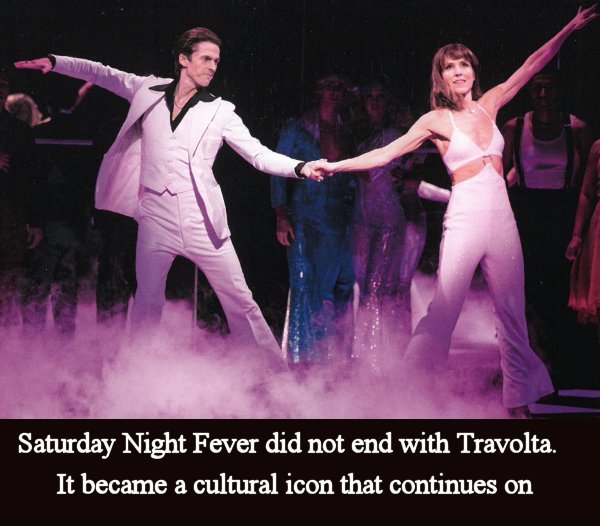 |
So here is the
question I wanted to ask.
"Mr. Felker,
when you got hoodwinked, did it ever occur to you that you
were Cosmically Blinded so Nik Cohn could attain his
Destiny?"
I am just
teasing. I would have had too much respect for Clay Felker to
assume I have the right to ask such an impertinent question.
Nevertheless, in manner similar to Lance Stevens, surely
Clay Felker had to wonder how Nik Cohn, a menial staff
writer for whom he had little regard, managed to pull off a
half-million dollar score.
How do you suppose
Mr. New York felt about this? Personally, I think the most bitter man in America had to be
Clay Felker.
|
Readers may
recall I am fond of an Arabic Proverb known as "Two Days".
This proverb suggests that Life consists of alternating
cycles of Brightest Day-Darkest Day, Good Luck-Bad Luck.
When it is your Brightest Day, you can do no wrong.
When it is your Darkest Day, nothing seems to go right.
Something I have
always found fascinating is how people who are truly gifted
seem to have periods of their life where they really
struggled. Then one day I came across a unique J.K.
Rowling quote.
"Talent and intelligence will not inoculate anyone
against the caprice of the fates."
To me, this
quote suggested that we all are going to experience
hardship, even people with money, privilege, talent,
intelligence, and friends. Obstacles are programmed
into our life and we have to deal with them.
Currently in our
story, Stigwood, Cohn, the Bee Gees and Travolta have
embarked on their Brightest Day. Clay Felker?
This is his Darkest Day.
|
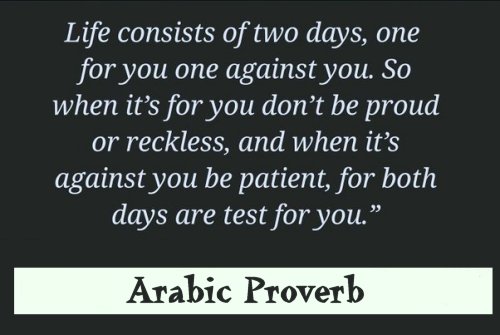 |
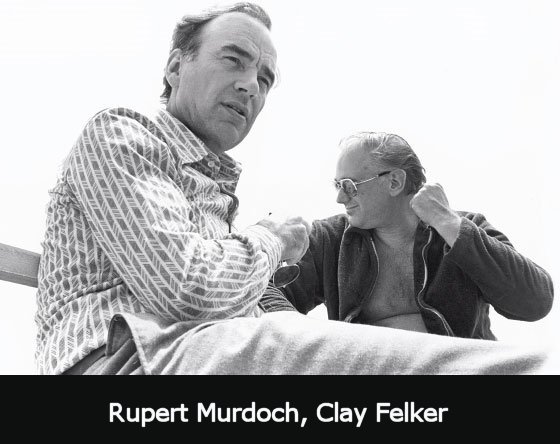 |
The main reason Nik Cohn got
away with highway robbery is because Clay Felker was badly distracted.
Felker was in the fight of his life trying to maintain control of
his magazine.
Felker was up against a
ruthless billionaire named Rupert Murdoch. Making matters worse, it was his
own fault for letting the fox inside the henhouse.
Of course we have to ask why would Felker let his guard
down. If you agree with Joanne Rowling, Talent and
Intelligence are no guarantee of protection against a loss
of Common Sense.
Felker was a terrific
editor, but he had one major weakness... he liked to spend
other people's money. Felker's expenses were
so exorbitant, they out-stripped the magazine's resources.
His lavish spending on limousines, office space, costly
parties and personal
chefs drew heavy criticism from his magazine's board of directors.
One day Felker demanded they buy him a house in the
Hamptons so he could throw bigger parties. That was the last straw. Clay Felker had
grown too big for his britches.
In 1976, New York was going broke. Fed up with
his
rampant spending, the board of
directors told Felker to find a solution or start looking
for another job.
Clay Felker had recently been introduced to Australian media
mogul Rupert Murdoch by Katherine Graham, publisher of the
Washington Post. Graham asked Felker to
show the new kid in town around New York. The two
became fast friends, lunching downtown, lounging seaside in
the Hamptons and discussing mutual business ventures.
|
In November 1976, Felker made a bold move.
Taking note of Murdoch's deep pockets, Felker mentioned his boardroom
problems to his potential sugar daddy. Felker casually asked if Murdoch might be
interested in making an investment in the magazine.
Murdoch's eyes lit up immediately. Felker's suggestion was akin to asking the friendly
neighborhood fat boy to
watch his hot dog for a while. Murdoch smiled
politely, then offered an invitation. "Why,
sure, Clay, why don't you drop by the beach house this weekend?
Let's
have a talk!"
Felker must have been in some sort of fog. Or perhaps
he had fallen under the spell of 'Cosmic Stupidity'.
You knew I was going to bring that up, didn't you? Ordinarily a shrewd man with killer instincts, Felker
had missed what Nik Cohn was up to and now he missed
what Rupert Murdoch was up to as well.
Felker
did not seem to understand was that Murdoch was looking to
expand his media empire. That was why Murdoch had come to
New York in the first place. Murdoch had started with
the purchase of the New York Post,
a blue-collar tabloid. Now for his next conquest, wouldn't it be nice to have a
way to reach the city's wealthy movers and shakers?? Thanks to Felker's big mouth, Murdoch had just realized
the smart,
sophisticated New York magazine was in play. Murdoch
licked his chops.
Meanwhile Felker remained blind to the danger. He was
so certain that Rupert Murdoch was a well-meaning buddy,
Felker poured his heart out to Murdoch during that fateful
weekend in the Hamptons. Journalist Susan Braudy
offered this startling eye-witness account:
|
"I had dinner with
Rupert and Clay
at
Murdoch's rented house in Southampton. I was there
as a weekend houseguest of Clay Felker, the
publisher of New York magazine. Murdoch's
daughter and son served steak and fresh baby peas. Flawlessly
tasteful. Intimate. A stealthy trap. For Murdoch, the
dinner party was a high-level espionage mission.
Clay had no
inkling that Murdoch was secretly positioning himself to
steal New York magazine out from under him. Clay was loquacious
throughout the meal. He explained Manhattan things to
Murdoch who Clay clearly saw as a bit of an Aussie rube. Clay
waxed eloquent about his writers Aaron Latham and Gail Sheehy (who were
also present at the meal). He explained my presence in
terms of Ms Magazine which he had helped
launch and where I wrote and edited.
Clay bragged about
his fabulous parties. He confided to
Murdoch that he got his best stories by listening to
dinner party conversation. He was oblivious that
this time it was Murdoch who was doing the listening,
turning the tables so to speak. Clay got no stories
at this dinner because Murdoch said almost nothing. He
asked one or two flattering questions and that was it.
Murdoch was doing to Clay what Clay usually did to
everyone else... listen.
A month or so
later, Murdoch seized New York magazine
and instantly fired Clay despite assurances to the
contrary."
|
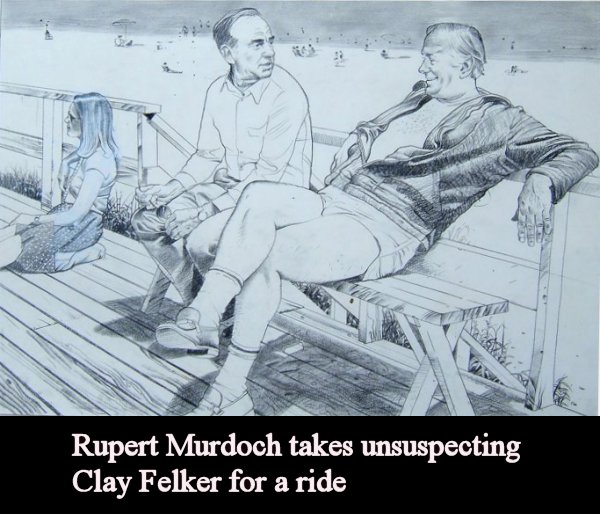 |
Clay Felker had been out of his mind to speak so candidly to
the fox.
Andrew Tobias, one of Felker's writers, had this say:
"Clay was not great with money. He was always
asking me for financial advice like how he could stint
on his editorial package. Clay's bread and butter
was creativity. The stories and graphics and
writing meant far more to him than profits. Then
came the day he met a terrific young Australian
publishing tycoon. Clay told me, "Andrew, you've got to go meet this guy!"
Clay assumed he was setting up Murdoch to be
his shining knight. When Clay sent me over to visit Rupert Murdoch,
Murdoch ended up interviewing me about the magazine.
That's when I got that funny feeling. Sure enough,
to Clay's
consternation, Murdoch grabbed the magazine right out from under him."
Once Murdoch realized Felker had alienated the board of
directors, he saw his opening. At the same time
Murdoch was sharing meals with Felker, he was negotiating
behind Felker's back with the magazine's majority
shareholder. Murdoch waved big money at the Board and
they took it.
Clay Felker never saw it coming until it was too late.
Once he realized what Murdoch was up to, Felker tried to persuade
his friend Katherine Graham at the Washington Post to
intercede. When Katherine Graham learned of Murdoch's backdoor
dealings, she called Rupert Murdoch to beg him to
reconsider.
"Don't do this to the boy, Rupert. Don't destroy this boy, don't take this boy's
magazine from him."
Murdoch could
have cared less. Murdoch sensed
weakness. He was a shark and there was blood in the
water. Felker might be a great editor, but he was
a bad businessman. The moment Murdoch bought the
New York
magazine, he told Felker to hit the road.
Despite Felker's deep connection to his baby, Felker was of
no use to Murdoch. He didn't want Felker around.
A ship cannot have two captains.
Felker felt betrayed, stabbed in the back.
He expected Murdoch would help him acquire
New York magazine,
not take it for himself. He had trusted the wrong person.
Felker was down to one last hope.
His stable of talented writers
was deeply loyal. They threatened to revolt
if Murdoch fired Felker. However, the writers got nowhere.
Murdoch called their bluff. If they left, Murdoch said
he would replace them
faster than the furniture. There's always another
college graduate hungry to make their mark. Besides, try finding another job in
this market, especially after Murdoch put the hex on them. The revolt collapsed
faster than a punctured balloon.
Here is how Richard Reeves, one of Felker's stunned writers, put it:
"This was a time that
we all thought the power was with the writers,
with the creative people. We were wrong. In a way we
were forced to learn what
they already knew in Hollywood: That's not the way it is.
The power is with the money. While we wrote about
that all the time, and while Clay understood that fact
of life
intellectually, as a businessman I don't think he got it."
1976 and
1977 were tough years for Felker. He
was outsmarted by Nik Cohn, outfoxed by Rupert Murdoch.
The toughest blow of all was losing his beloved
magazine. When
Murdoch showed him the door, Felker was
heart-broken and devastated. He was also out of a job.
Humiliated, Felker
lost his pride, he lost his job, he lost his reputation
and he lost the most precious thing in the world, the magazine
he had created. Clay Felker had been synonymous with
New York magazine. But
not any more. People laughed at his downfall.
Clay Felker was called a loser, a chump.
|
Media mogul Rupert Murdoch, a
supposed friend,
had
betrayed a gentleman's agreement in order to seize control of
New York
behind Felker's back.
After
Murdoch confiscated the magazine,
Felker was unceremoniously
fired. Not only did Clay Felker lose the most
important thing in his life, he was badly humiliated when
news of his
failure in the
nasty power struggle became public knowledge.
This was a painful blow. No one but
Felker knew the inside story how Nik Cohn had embarrassed him.
However, the
Murdoch situation was much different.
Felker's giant
reputation was badly tarnished when news came out how
Murdoch had tricked him. Imagine what it must feel
like to become the laughingstock in the media capital of the
world.
On a personal note, I was very drawn to Felker's story.
It reminded me of the dread I felt back when the
fall of Disco threatened my dance program. Quite
frankly, New
York was just as important to Clay Felker as my
dance program was to me. It was his baby, his reason
to exist. I also related to Felker's bitter defeat at
the hands of the cunning Mr. Fox. Clay Felker's big
mouth cost him his job the same way my big mouth got me
thrown out of graduate school. The knowledge that I
had caused my own downfall was searing, so I imagine Felker
was equally devastated. No doubt he was keenly aware
his self-destructive behavior had gotten him into this fix.
Brightest Day, Darkest Day. This was Felker's Darkest
Day.
Saturday Night Fever
was being filmed in Brooklyn at the same time that Clay
Felker was wrestling with Rupert Murdoch. Shortly
after Felker was fired in late 1977, the movie debuted in
December. At the exact moment
Clay Felker was thrown out, he was forced to watch helplessly as box office and soundtrack made
Saturday Night Fever one of the most lucrative films in
cinematic history.
This had to be the lowest moment of his
life.
Everyone who touched this movie got
rich. Nik Cohn came away with $500,000. Robert Stigwood made $300
million. Travolta and the Bee Gees rocketed to
stardom. Felker was aghast to realize he was the big loser
in this amazing bonanza. In particular, he seethed at
the indignity of letting Nik Cohn leapfrog to the
stratosphere using his unwitting shoulders for lift-off.
Bitter
at his fate, Clay Felker decided he had a score to
settle.
Feeling like a chump, it is fair
to assume Clay Felker sought redemption.
But what was he going to do about it?
|
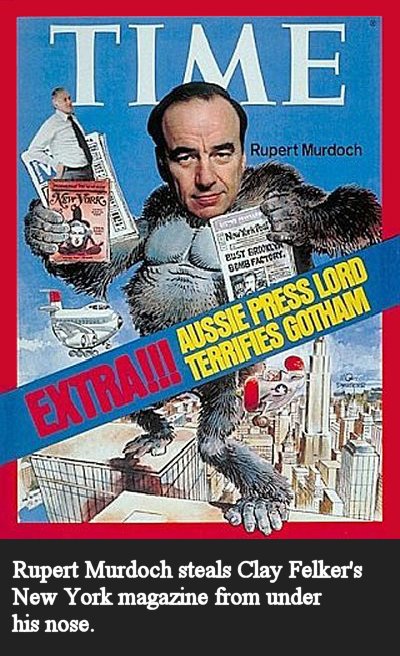 |
Rick Archer's Note:
Keep
scrolling.
The story of Clay Felker's
comeback attempt follows below.
Thank you
for reading!
|
|
MAGIC CARPET RIDE
the disco
years
CHAPTER EIGHTY SEVEN:
REDEMPTION
Written by Rick
Archer
|
|
 |
Rick Archer's Note:
'Casey at the Bat'
is the classic American metaphor for the dangers of complacency.
Mighty Casey is the best baseball hitter of all time.
He has never failed in the clutch. Casey is so
confident in his ability to hit the ball that he is unable
to fathom striking out when it matters the most. When he went to bat
for Mudville's big game, Casey was so sure he would hit a home run that he didn't
bother swinging at the first two pitches.
Unfortunately, when Casey
swung at the third pitch, he missed it completely.
Strike Three. Casey was out, game over.
|
In 2007,
Sam Kashner penned a detailed 17-page account about how
Saturday Night Fever
was made. Kashner dutifully added the name of every
single person involved in the project.
Writer Nik Cohn's name was listed prominently.
Rumor has it that Cohn made upwards of a half
million dollars in return for his unethical behavior
in sneaking a false story under Clay Felker's nose.
Producer Robert Stigwood's name was listed prominently.
Trusting his instincts, Stigwood was rewarded with
$285 million box office and $40 million soundtrack
based on a $4 million investment.
What about Clay
Felker? Without his permission to run the
story, Cohn and Stigwood would have never made their
fortune.
Considering the
thoroughness of Mr. Kashner's article, if Clay
Felker had been involved in the making of Saturday Night
Fever, we would suppose his name would have appeared,
yes??
In a 10,000
word article,
Clay Felker's name was nowhere to be seen. Well,
actually, change that. His name did appear
once:
"Cohn went back to the disco with artist James
McMullan, whose illustrations for the article
helped persuade Cohn's underwhelmed editor in
chief, Clay Felker, to run it. The title
was changed from "Another Saturday Night" to
"Tribal Rites of the New Saturday Night," and a
note was added insisting that 'everything
described in this article is factual.'"
|
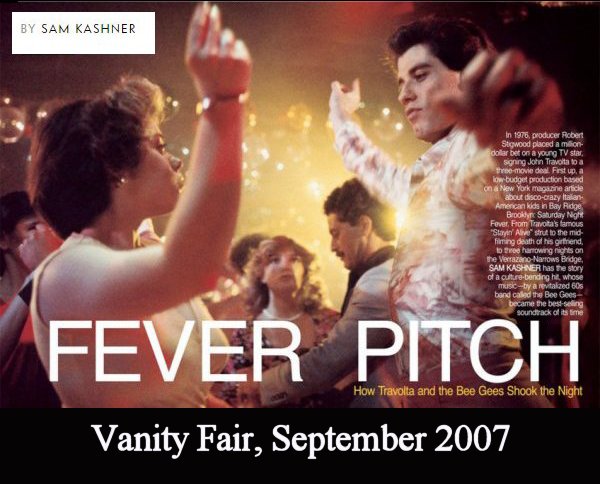 |
If we analyze
this development from a Mystical point of view, a
case can be made that Clay Felker's usual sharp
instincts were dulled by Cosmic Blindness.
Suffering through his Darkest Day, Felker's mistake
allowed Nik Cohn and Robert Stigwood to enjoy their
Brightest Day. Or we can ignore
the Mystic implications and just say Felker had a
bad day at the office. Distracted by his
problems with Rupert Murdoch, clearly Felker was on automatic pilot
when he published the Disco
story. Imagine his stupefaction when the story became important
to the tune of $280 million box office and $40 million
soundtrack based on a $4 million investment.
Felker
was undoubtedly fit to be tied. How
on earth could he have missed this Disco phenomenon? After
all,
wasn't Clay Felker supposed to be the ultimate trend-spotter?
Clay Felker was the man who prided himself in spotting
trends before all others. And yet the one time his
talent could have really paid off, Felker missed it. Disco
was a trend that had been placed right under his nose and
all he did was sniff with contempt. Now everyone
around him was getting rich and Felker had
absolutely nothing to show for it. Given that Felker
never made a dime off the cultural phenomenon that
defined the Seventies, I would imagine Clay
Felker felt badly used. I have to believe that
Clay Felker became obsessed with getting the chance
to set things right.
|
|
Rick Archer's Note:
Before we begin, let me remind everyone that my story about Clay Felker is based on
best-guess insights gleaned from stories found on the
Internet. I put myself in his shoes and tried to
imagine what went through his mind. Given that I have
no first-hand knowledge, I cannot promise
100% accuracy. However, I think I came close. Personally, I
find the story of Felker's Comeback
Trail to be remarkable.
|
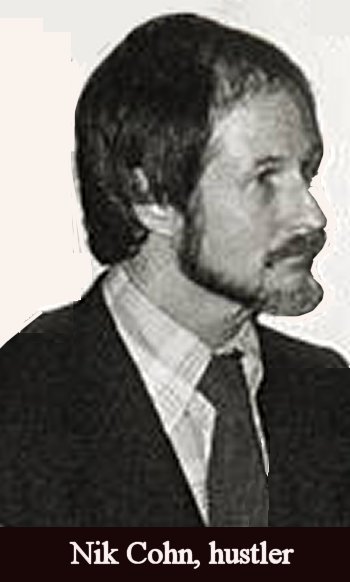 |
One of my
favorite stories about Saturday Night Fever
was the L.A premiere party on December 7, 1977.
Faces in the crowd were all sorts of celebrities
including Farrah Fawcett, Chevy Chase, Jim Brown,
Michael York, Kristy McNichol, Carly Simon,
John Travolta, Robert Stigwood, and the entire cast
from the movie.
Sitting at home
that night in New York was Clay Felker. He was
not invited to the premiere. Why not?
Because he did not have a single thing to do with
the movie. Felker was not in a good mood.
For one thing, he was unemployed thanks to a certain
Mr. Murdoch. In addition, he was astonished at
the reception Stigwood's movie was garnering.
His mood grew worse when he heard this virtually
unknown movie had become a box office bonanza to the
tune of $280 million based on a $4 million
investment.
One also has to
wonder when he saw that Nik Cohn was there that
night accompanied by his date, the glamorous Yvonne
Elliman. To refresh your memory, Ms. Elliman
had a Number One hit on the soundtrack titled "If
I Can't Have You."
Nik Cohn.
Half a million. Yvonne Elliman. National
acclaim. That's Hollywood, baby. My
guess is that Felker wanted to murder the guy.
|
 |
For all the success tales that weaved through the improbable
Saturday Night Fever saga, there was one
person who was left with his bat on his shoulder.
Clay Felker. He struck out. Try to imagine how Felker felt when the movie proceeded
to make everyone wealthy and
famous beyond their wildest dreams, everyone but him that
is. Clay Felker was proud man reduced to a
laughingstock. Start spreading the news... Once the
talk of the town, rumor had it that Rupert Murdoch and
Nik Cohn had outsmarted the great Clay Felker while Robert Stigwood had waltzed off with the Grand Prize.
Filled with bitterness, my guess is Clay Felker craved a
second chance.
I
doubt seriously Clay Felker ever got even with Rupert
Murdoch. However, I am
quite sure Felker wanted to get even with Nik Cohn.
He probably wanted to strangle the guy. Considering
Felker's extensive contacts, I imagine he knew a mob boss or
two willing to do him a favor. Probably the only thing
that saved Cohn's life was the fact that Clay Felker did not
yet know the Disco story was a complete fraud.
As for Robert Stigwood, I cannot see where Stigwood did
anything wrong. Yes, he paid a King's Ransom for the
fake Disco story, but that had nothing to do with Felker.
If there were hard feelings between Stigwood and Felker, I
remain unaware. However, I imagine Stigwood's uncanny
success wounded Felker's pride. It is likely that Felker wanted to prove he was
just as smart as Robert Stigwood.
The moral
of Casey at the Bat is to swing at every pitch because you might not get another chance.
1976 was the year that Mighty Clay Felker struck out.
Still smarting from letting the Nik Cohn story sneak out from under his nose,
I believe Felker craved a second chance. I would bet
money that Felker became obsessed with
payback. Felker had an idea. If Nik Cohn could trick him, then he could trick
him right back. He had a plan to beat Nik Cohn and Robert Stigwood at their own
game. As we shall see, Felker's plan had an element of genius.
Felker's first move on the comeback trail was to get a job
as publisher and editor of Esquire Magazine in
1977. This turned out to be a shrewd move. His
next move was to look for a way to hijack Stigwood's
lucrative
sequel to Saturday Night Fever before Stigwood did it himself.
How do you steal a Sequel? Good question. Stigwood
owned the legal rights to Saturday Night Fever.
No doubt Felker would be sued to oblivion if he tampered
with Stigwood's property. Felker decided his only choice was to
make some sort of 'Disguised Sequel'. Easier said than
done. How does someone make a Sequel that isn't a
Sequel?
Looking for an answer to that question became Felker's
burning obsession.
Felker knew if he could find the right vehicle, he had the contacts and the skill to
pull it off. Felker had just as many
show business contacts as Stigwood. In addition,
Felker knew the Saturday Night Fever formula
by heart. Throughout the filming in Brooklyn,
Felker occupied a catbird seat which allowed him to
study every move Stigwood made. The problem was
finding the right vehicle. Fortunately, finding gold
in obscure stories was Felker's greatest skill. If the master trend spotter
could track down something similar to the
Disco story, he was certain he could emulate Stigwood's success.
|
After taking control of Esquire in 1977,
Felker began his search in early 1978.
Did anyone besides Felker know what he was up to? Perhaps
his wife Gail Sheehy and a few close friends, but Felker had
learned his lesson the hard way... Keep your mouth shut!!!
No more handing the farm to people like Murdoch.
So why the need for silence?
If Stigwood had the slightest idea what he was up to, the
game would be over. Felker smartly kept his cards to
himself lest this opportunity slip away. Even so,
Felker was not terribly optimistic.
Racing to beat Stigwood to the coveted Sequel,
Felker knew his secret plan was a long shot at best.
The thing about Darkest Day is that one's Brightest Day may
be right around the corner. Just remember to be
patient. Suddenly Felker got hot. He got a huge
break came when Stigwood decided there was no hurry to film
a sequel. Grease wrapped up
filming in California spring of 1978. Felker assumed Stigwood would
now turn his attention to making a Saturday Night Fever
sequel, but it did not happen. Since Stigwood had no idea Felker was
chasing him, he decided it was too soon to film the SNF sequel.
Instead Stigwood turned his attention to making Sgt.
Pepper's Lonely Hearts Club Band, a 1978 musical mishmash starring the Bee Gees.
The irony here is that Grease marked the end
to Stigwood's Brightest Day. Now it was time for his
Darkest Day to begin. While Stiggy was in the process
of making three of the worst movies of all time, Felker was
looking to steal his Sequel.
|
 |
Given this unexpected reprieve
by Stigwood, Felker scoured the land for some sort of idea.
This was not as easy as he expected. It took over six
months to find what he wanted. Finally Felker found
what he wanted. His inspiration took place on a summer
trip to Texas. In June 1978 Felker came to Houston to give a Journalism speech over
at Rice University.
Stigwood and Felker were on alternating Brightest
Day-Darkest Day cycles. Ironically, Felker's plane
touched down in Houston at virtually the same moment as one
of the great turkeys of all time, Stigwood's Sgt. Pepper's Lonely Hearts Club Band, was being
released.
Stigwood's star fell as Felker's rose.
The same held true for me. Felker's Darkest Day was my Brightest Day.
Stigwood's Saturday Night Fever launched my
career as a Disco teacher. Now Felker's
Brightest Day would create my Darkest Day. His grand
scheme to steal Stigwood's sequel is what put a premature
end to my career as a Disco teacher. Very curious how
this works, isn't it?
In June 1978 Felker was feeling dejected. Ever since the debut of
SNF, Felker had spent month after month scouring the land for a
solution to his 'Sequel' problem without success.
The clock was ticking and nothing had caught his eye.
The Houston airport made Felker's bad mood worse. As
he
walked through the terminal, Felker was surrounded by
neverending
images of
Saturday Night Fever. Now that the movie
had become the
reigning talk
of the land, Disco Inferno was raging. Felker was reminded of his
shame by Disco merchandise in every shop
he
passed. No doubt Felker
cringed each time he saw a picture of John Travolta to remind
him of his oversight. Wouldn't it be nice if he could
produce a movie of his own? Then he would be the one
to sell the merchandise in airports among other places. Gritting his teeth, Felker vowed to find a way to even the score or go nuts
trying.
|
Little did Felker realize
his luck was about to turn.
Felker was met at the airport by Bill Broyles,
editor of Texas Monthly magazine,
and Mike Levy, the publisher. They were sponsors of the media event
being
held at the Rice University School of Journalism.
First the men took Felker to dinner. Then Levy
and Broyles asked him what he wanted to
do next. It was late, 10 pm. Was he tired?
Would he like to go back to the hotel?
Felker shook
his head. Felker said he had never visited Houston
before. Would the men mind showing him around the city?
Broyles and Levy were more than happy to oblige.
As the three men got into Levy's car, Broyles suggested they visit élan,
Houston's favorite Disco. élan was just blocks away from
Felker's Galleria hotel.
Visit a Disco? Felker nearly vomited.
That was the last place he wanted to go. After
Felker said he could not stand Disco, Levy decided to try a different look at Texas-style nightlife. On
impulse, Levy and Broyles
drove Felker to wild and wooly Gilley’s in
neighboring Pasadena.
The moment Felker walked in the door, his
eyes grew wide as saucers. This vast honky-tonk
featured a country band, country dancing, a mechanical bull,
punching bags, pool tables, and scores of urban cowboys on
the prowl for urban cowgirls.
This was it! The moment Clay Felker saw dozens of
couples dancing to western music, the tumblers fell into
place. Felker had just found what he was looking
for. Felker's instincts said Gilley's was the
honky-tonk equivalent of
the Disco featured in Saturday Night Fever.
Felker had just hit the Jackpot!!
|
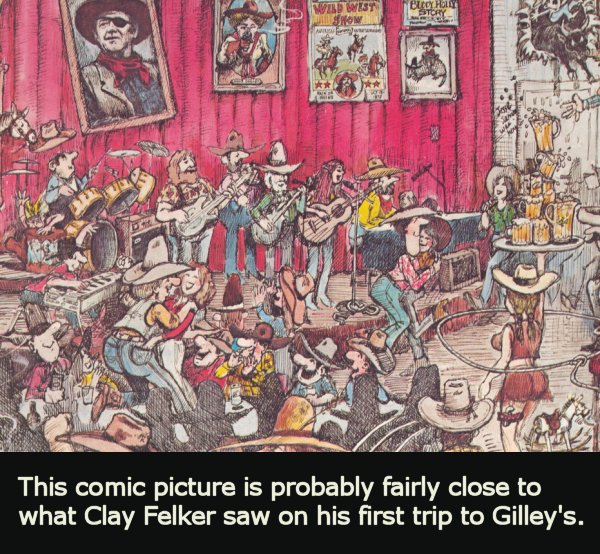 |
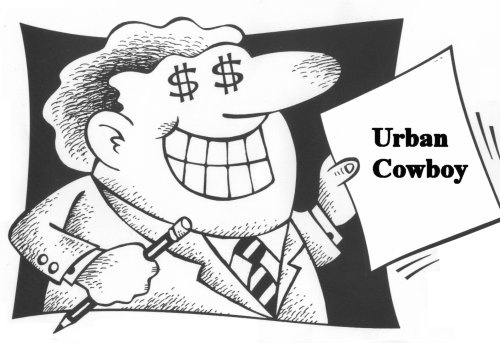 |
Previously Nik
Cohn had been in the right place at the right time.
Now it was Clay Felker's turn. Gilley's had given Felker the second chance he prayed for.
Give the man some credit. Right now two thousand
people were participating in what had to be the most alien
environment imaginable to Felker's elitist Eastern
sensibilities. It took some genuine
imagination to see the next 'Saturday Night Fever'
amidst this beer-fueled honky-tonk madness.
Fortunately, Felker was not put off by the
strange sight. Not at all. Felker's vision was
filtered through a rose-colored lens known as dollar
signs. Felker smiled. He was back in the Game.
Here is what I like about this story. How many people
could visit Gilley's and see its potential?
It would never occur to me, what about you? How many
people have the ability to see a run-down,
smelly honky-tonk
like Gilley's and make it sound like the second coming of Xanadu? Don't ask me
how he did it, but
Felker threw Ugly
into his spin machine and made Badass
sound beautiful.
Felker was about to
singlehandedly create a
National Country-Western Trend out of THIN AIR.
|
Give
the man some credit. Felker had the advantage of
knowing what he was looking for. There's old saying: "If
a pickpocket were to see a Saint, he would notice only the
man's pockets." If you or I visited Gilley's,
we would see the bull, the beer and the brawling. Clay
Felker was said to have a gift for spotting things others
missed. His instant recognition of Gilley's
as a substitute for the Brooklyn Disco club that served as
the setting for SNF was the perfect example.
Apparently this search had been on Felker's mind for a long
time. I base this conclusion on the fact that Felker
instigated his plan the moment he returned to his Houston
hotel that night.
On the drive back to the hotel, Felker said nothing to
Broyles and Levy, his Texas
Monthly friends, about his vision. Now that he
had found his pot of gold, Felker determined that stealth
was mandatory.
|
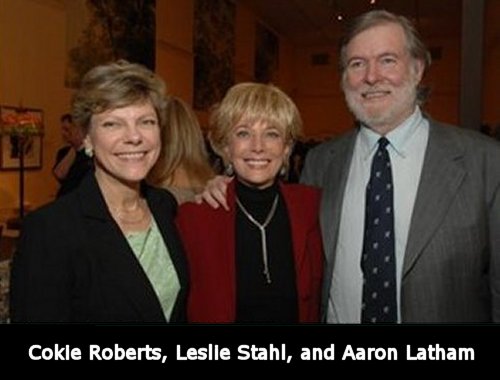 |
Preparing to beat Robert Stigwood to the
punch, Felker wasted no time.
Felker needed a country-western story similar to the Nik
Cohn story and he needed it fast. Minutes after
entering his room, Felker called his writer
friend Aaron Latham
at 3 am.
"Aaron,
get on a
plane and get your butt down to Houston pronto!"
Aaron Latham was a Washington DC resident
married to
long-time
60 Minutes correspondent Leslie Stahl. Although
Latham was born in West Texas, he went to college at Princeton.
After graduation, Latham remained on the East
Coast to begin his career. Latham had been Felker’s primary
Watergate reporter at New York in the early Seventies.
Developing a close rapport, Latham and Felker became amigos. This was good
because Felker needed someone he could trust.
If one word of his plan leaked out, Stigwood might cut him
off at the pass.
Aaron Latham had never heard of Gilley's, but that
didn't matter. Following Felker's emergency phone
call, Latham made a beeline to Houston. He understood
his mission.
Felker wanted him to cut and paste Cohn's Disco story into the
C&W environment at
Gilley's. Latham quickly
fast-tracked the
script that would give birth to Felker's precious 'Sequel in Disguise'.
|
Clay Felker introduced Aaron Latham to Sherwood Cryer, co-owner of Gilley's. As
the two men walked around the club, Cryer advised Latham on
various angles for the Esquire article.
Sherwood
Cryer had a big smile on his face. Cryer enjoyed walking
this stranger through the cavernous paths because Felker
had confided in him. After swearing Cryer to secrecy,
Felker confessed he intended to make
Gilley's the C&W equivalent of Saturday Night
Fever. Based on that conversation, Cryer crossed his
fingers. It was crazy to believe, but Latham's story
might just put
Gilley's
on the national map.
During his tour of the club, Latham met some
interesting Gilley's
regulars including the colorful operator of the mechanical
bull. Unbeknownst to Latham at the time, the bull
operator was an escaped convict hiding in plain sight here at
the club. The man somehow persuaded Latham into riding
the mechanical bull. Latham must have been a brave man.
Since beginners were sure to be thrown, it
took real guts to get up on that violent machine.
Sure enough,
Latham was quickly thrown off the bull. Latham
was hooked. Undeterred, he spent the rest of the
day trying to master the mechanical bull. Bruised,
beaten, sore all over, Latham laughed at how seriously he had
taken the challenge. He vowed to
make this mechanical beast the surprise star of his story.
Latham
hung around
Gilley's for a month. He
interviewed everyone in sight and
rode the bull every chance he got.
The more people he talked to, the more he realized many of
them had grown up in the Texas countryside just like he had.
They had moved to the big city to chase factory
jobs created by Houston's booming economy.
The Gilley's regulars brought their country ways with
them. Boots, cowboy hats, trucks,
Wrangler jeans, and love of country music played a big part
in who they were.
These people were straddling two worlds, City and Country,
part-Urban, part-Cowboy.
Latham smiled. Referring to these
uprooted kickers as 'Urban Cowboys', Latham's story would revolve around young men,
many of them chemical plants workers, who spent every spare evening
trying to impress women by riding the mechanical bull and looking for love on the dance floor.
Latham stated “the cowboy, the most enduring symbol of our
country,” needed to be reinvented, generation after
generation, by people of the American West.
In September 1978, Latham's
Ballad of the Urban Cowboy and America's Search for True Grit appeared in
Esquire. This was undoubtedly one of the most pretentious
titles in history, but so what. The important thing was
Clay Felker's good sense to place a powerful subtitle
on the cover of his magazine:
'Saturday Night
Fever, Country-Western style'!!
Clay
Felker's headline worked like a charm. He made a
phone call to the same guys at Paramount Pictures who had
released SNF. The moment they got the
hint: 'Disguised Sequel!',
they took the bait. Then came Irving Azoff,
business manager of the rock band Eagles and several others.
He saw the chance to do for his
country music artists what Robert Stigwood had
previously done for
the Bee Gees. Azoff won the soundtrack bidding contest and began
producing Urban Cowboy. In a blinding
stroke of good fortune, John Travolta was available.
With Travolta on board, the success
of the movie was guaranteed. Pasadena, Texas,
became Brooklyn
with boots on, with a
hard-hitting story of directionless youth
with John Travolta as the Dancing Cowboy.
|
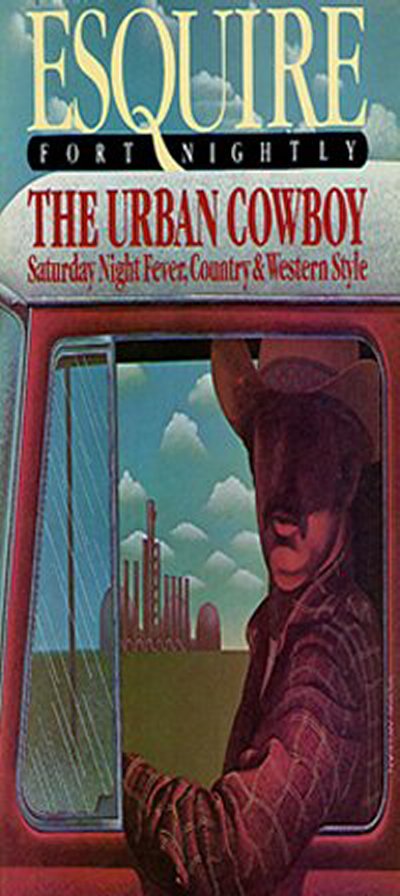 |
I
have to believe that Clay Felker's Urban
Cowboy project must have been deeply satisfying to
him. Considering the hardships he
had faced, Felker was
surely proud of himself. Putting this 'Disguised Sequel'
project together was an extremely clever move. But it
was not an original move. All Felker had to do was
follow the Nik Cohn-Robert Stigwood formula.
First, get control of Esquire, a substitute
for New York magazine.
Second, find a substitute for the Disco that served as the
location for SNF.
Third, hire Latham to replicate the Nik Cohn story featuring
directionless youth who spent countless hours dancing in a
club.
Fourth, publish the story in Esquire to drum
up interest in Latham's sto
Five, stress the Sequel aspect, "Saturday Night
Fever, Country-Western style"
Six, get John Travolta to emphasize the sequel angle.
Seven, contact the same guys at Paramount who had made a
fortune off SNF
Eight, sell the music rights to an Urban Cowboy soundtrack
item
Nine, market C&W clothing
Ten, publicize the movie to every media outlet in the
country using Felker's many contacts.
|
|
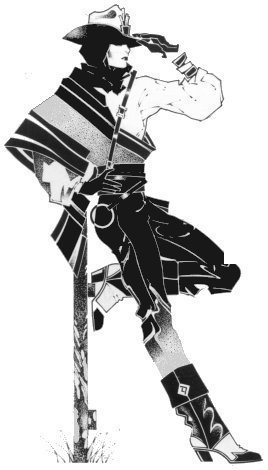 |
Clay Felker had the sense to
capitalize on his contacts in a very unique way. My
guess is that Felker began selling his Sequel to Hollywood
before Latham's story was even finished. There is ample circumstantial evidence to suggest Clay Felker contacted
everyone on his Rolodex regarding tie-ins to the movie.
It cannot be a coincidence that the
United States was inundated with Country-Western fashions
prior to the release of the movie. Nor can it be a
coincidence that the movie soundtrack was released well in
advance of the movie release. This, of course, was a
technique that Stigwood had introduced. In other
words, all the marketing was in
place long before the public had the slightest idea this project even
existed. Felker would go to orchestrate one of the
great pre-movie publicity campaigns in cinematic history.
This is speculation on my part, but it stands to reason that Clay Felker
tipped off Lance McFaddin. McFaddin was the director of Houston-based
McFaddin-Kendrick,
the company that specialized in opening fancy nightclubs
such as Foxhunter, élan, Ciao, Rodeo, and Cowboy.
Where do you suppose Lance McFaddin came up with his
ground-breaking idea to open a stunningly beautiful
counterpart to Gilley's, the ugliest club on
the planet? I am certain McFaddin used insider knowledge to
commission market research on the viability of an 'Upscale
Western Club'. Pleased with the survey results and privy
to the secret of Aaron Latham's upcoming Esquire
story, McFaddin decided to take a huge gamble and authorize
the expensive remodel of
Foxhunter necessary to create Cowboy.
McFaddin-Kendrick's February 1979 debut of Cowboy
became the opening
shot in Houston's Western Transformation. Once
the other club owners saw the overwhelming success of
Cowboy, they rushed to join the bandwagon.
So now we know the story behind the curious Disco-to-Western
chain reaction that ended my career as a Disco teacher. The movie box
office was $53 million, soundtrack earnings were $47
million. Although Saturday Night Fever
exceeded $400 million, this tidy $100 million payoff was
nothing to sneeze at. I think Urban Cowboy
did pretty well considering it was at best a rather tedious rip-off.
For that I tip my hat to Clay Felker, the Wizard of Oz.
|
|
|